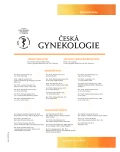The role of maternal imunity and woman´s microbiome in the pathogenesis of preterm labor
Authors:
M. Koucký 1; K. Malíčková 2; J. Hrdý 3; A. Černý 1; H. Hrbáčková 1; Patrik Šimják 1
; A. Pařízek 1
Authors‘ workplace:
Gynekologicko-porodnická klinika 1. LF UK a VFN, Praha, přednosta prof. MUDr. A. Martan, DrSc.
1; Ambulance klinické a reprodukční imunologie Ústavu lékařské biochemie a laboratorní diagnostiky 1. LF UK
a VFN, Praha
2; Ústav imunologie a mikrobiologie, 1. LF UK a VFN, Praha
3
Published in:
Ceska Gynekol 2017; 82(5): 407-410
Overview
Objective:
To summarize available data concerning the role of maternal imunity and woman´s microbiome in the pathogenesis of preterm labor and their use in clinical practice.
Setting:
Department of Obstetrics and Gynecology od the First Faculty of Medicine, Charles University in Prague, and General Teaching Hospital.
Design:
Review article.
Methods:
Compilation od published data from scientific literature.
Conclusion:
Preterm labor complicates approximately 10% of all pregnancies and represents a serious medical, social and economic problem. In the past, a lot of causes of preterm labor were discussed; infection, uteroplacental ischemia, decidual hemorrhage, uterine overdistension, cervical disease and maternal-fetal tolerance disorder were considered the most common. However, chronic inflammation seems to be the common pathogenic process underlying preterm labor, irrespective of the original stimulus. Currently, impaired maternal-fetal immunological tolerance represents most discussed topic. Growing scientific evidence suggests that the immune regulation of the maternal-fetal interface is the result of the coordinated interaction among maternal microbiota, trophoblast and maternal cellular components. From this view we understand preterm labor as a result of disruption of this process.
Keywords:
preterm labor, maternal-fetal immunological tolerance, maternal microbiome
Sources
1. Berghella, V. Universal cervical length screening for prediction and prevention of preterm birth. Obstet Gynecol Surv, 2012, 67, 10, p. 653–658.
2. Denny, KJ., Woodruff, TM., Taylor, SM., Callaway, LK. Complement in pregnancy: a delicate balance. Am J Reprod Immunol, 2013, 69, 1, p. 3–11.
3. Ferreira, LM., Meissner, TB., Tilburgs, T., Strominger, JL. HLA-G: at the interface of maternal-fetal tolerance. Trends Immunol, 2017, 38, p. 272–286.
4. Gomez, R., Romero, R, Ghezzi, F., et al. The fetal inflammatory response syndrome. Am J Obstet Gynecol, 1998, 179, 1, p. 194–202.
5. Kindinger, LM., Bennett, PR., Lee, YS., et al. The interaction between vaginal microbiota, cervical length, and vaginal progesterone treatment for preterm birth risk. Microbiome, 2017, 5, 1, p. 6.
6. Koucký, M., Smíšek, J. Spontánní předčasný porod. Praha, Maxdorf, 2014.
7. Lee, JH., Ulrich, B., Cho, J., et al. Progesterone promotes differentiation of human cord blood fetal T cells into T regulatory cells but suppresses their differentiation into Th17 cells. J Immunol, 2011, 187, 4, p. 1778–1787.
8. Madhukaran, SP., Alhamlan, FS., Kale, K., et al. Role of collectins and complement protein C1q in pregnancy and parturition. Immunobiology, 2016, 221, 11, p. 1273–1288.
9. Mor, G., Kwon, JY. Trophoblast-microbiome interaction: a new paradigm on immune regulation. Am J Obstet Gynecol, 2015, 213, Suppl., p. 131–137.
10. Prince, AL., Ma, J., Kannan, PS., et al. The placental membrane microbiome is altered among subjects with spontaneous preterm birth with and without chorioamnionitis. Am J Obstet Gynecol, 2016, 214, 5, p. 627.e1–627.e16.
11. Regal, JF., Gilbert, JS., Burwick, RM. The complement system and adverse pregnancy outcomes. Mol Immunol, 2015, 67, 1, p. 56–70.
12. Romero, R., Espinoza, J., Gonçalves, LF., et al. Inflammation in preterm and term labour and delivery. Semin Fetal Neonatal Med, 2006a, 11, 5, p. 317–326.
13. Romero, R., Miranda, J., Chaiworapongsa, T., et al. Novel molecular microbiologic technique for the rapid diagnosis of microbial invasion of the amniotic cavity and intra-amniotic infection in preterm labor with intact membranes. Am J Reprod Immunol, 2014, 71, 4, p. 330–358.
14. Rowe, JH., Ertelt, JM., Aguilera, MN., et al. Foxp3(+) regulatory T cell expansion required for sustaining pregnancy compromises host defense against prenatal bacterial pathogens. Cell Host Microbe, 2011, 10, 1, p. 54–64.
15. Rowe, JH., Ertelt, JM., Xin, L., Way, SS. Pregnancy imprints regulatory memory that sustains anergy to fetal antigen. Nature, 2012, 490,7418, p. 102–106.
16. Ruocco, MG., Chaouat, G., Florez, L., et al. Regulatory T-cells in pregnancy: historical perspective, state of the art, and burning questions. Front Immunol, 2014, 21, 5, p. 389.
17. Sasaki, Y., Sakai, M., Miyazaki, S., et al. Decidual and peripheral blood CD4 + CD25 + regulatory T cells in early pregnancy subjects and spontaneous abortion cases. Mol Hum Reprod, 2004, 10, 5, p. 347–353.
18. Shea, AK., Simpson, AN., Barrett, J., et al. Pregnancy outcomes of women admitted to a tertiary care centre with short cervix. J Obstet Gynaecol Can, 2017, 3, 5, p. 328–334.
19. Steinborn, A., Schmitt, E., Kisielewicz, A., et al. Pregnancy-associated diseases are characterized by the composition of the systemic regulatory T cell (Treg) pool with distinct subsets of Tregs. Clin Exp Immunol, 2012, 167, 1, p. 84–98.
20. Stout, MJ., Conlon, B., Landeau, M., et al. Identification of intracellular bacteria in the basal plate of the human placenta in term and preterm gestations. Am J Obstet Gynecol, 2013, 208, 3, p. 226.e1–7.
21. Wagner, MI., Jöst, M., Spratte, J., et al. Differentiation of ICOS+ and ICOS - recent thymic emigrant regulatory T cells (RTE T regs) during normal pregnancy, pre-eclampsia and HELLP syndrome. Clin Exp Immunol, 2016, 183, 1, p. 129–142.
22. Zhao, AM., Xu, HJ., Kang, XM., et al. New insights into myeloid-derived suppressor cells and their roles in feto-maternal immune cross-talk. J Reprod Immunol, 2016, 113, p. 35–41.
23. Ziegler, SF., Buckner, JH. FOXP3 and the regulation of Treg/Th17 differentiation, Microbes Infect, 2009, 11, 5, p. 594–598.
Labels
Paediatric gynaecology Gynaecology and obstetrics Reproduction medicineArticle was published in
Czech Gynaecology

2017 Issue 5
Most read in this issue
- What is the risk of pelvic organ prolapse recurrence after vaginal hysterectomy with colporrhaphy?
-
Screening of endometrial NK cells in selected infertile patients
First part – Methods and current results - Selective feticide in monochorionic twin pregnancies with discordant fetal anomalies: management and outcome
- Endometriosis and quality of life
